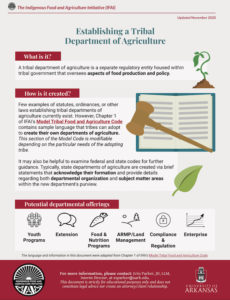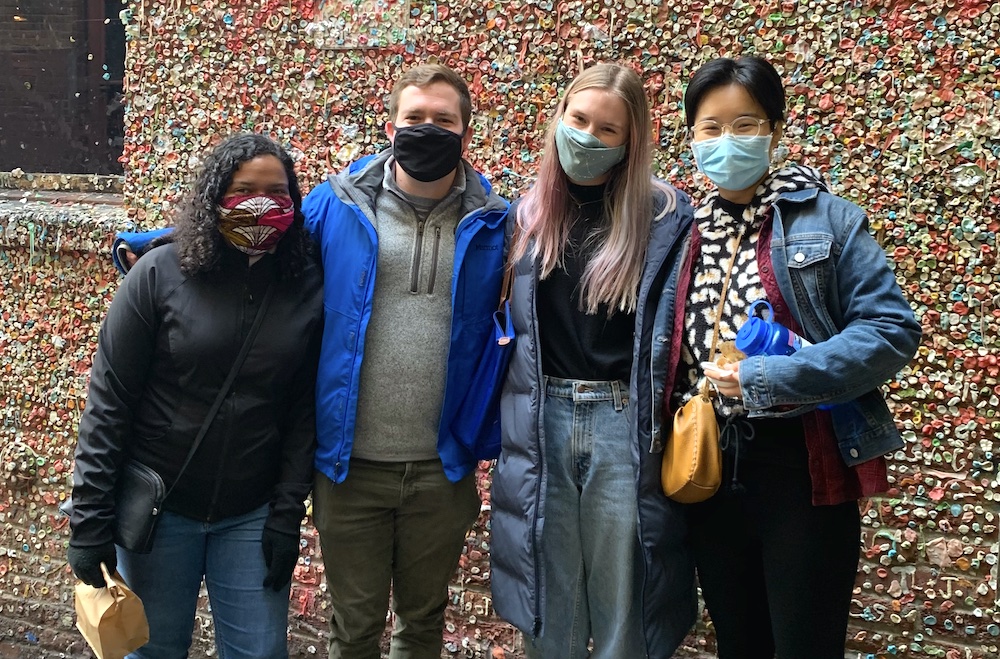Above: Joel Anderson, 27th Class Emerson Fellow.
When I first learned that I’d been placed with the Indigenous Food and Agriculture Initiative (IFAI) in Fayetteville, Arkansas, I was eager to learn more about the work being done to promote tribal sovereignty. It was a topic that I knew little about—and while my unfamiliarity initially made me anxious, my time with IFAI quickly opened my eyes to the countless issues facing Indian Country today.
Prior to the start of the COVID-19 pandemic, many systems that serve the 574 federally recognized tribes living in the United States were already falling short of expectations. At the end of 2018, the U.S. Commission on Civil Rights reported that federal programs designed to support the social and economic wellbeing of Native Americans were chronically underfunded and inefficiently structured, leaving many basic needs unmet and exacerbating longstanding inequities observed within Native American communities1. Since last March, the magnitude of these problems has only intensified due to the spread of COVID-19. With deteriorating health care facilities, inconsistent access to high-speed broadband internet, and disrupted food systems all contributing to Indian Country’s plight, the need for additional aid from governments and other organizations is urgent, necessary, and overdue.
While IFAI can’t address all of these obstacles, their efforts remain critical to the development of resilient food systems that foster tribal sovereignty. More specifically, the organization advances tribally driven solutions to revitalize and advance traditional food systems and diversified economic development throughout Indian Country2. By drafting educational resources, conducting policy research, and engaging in strategic legal analysis, IFAI frequently provides tribal governments, producers, and food businesses with the tools required to establish robust agricultural economies. In partnership with other Native-led organizations and initiatives—such as the Intertribal Agriculture Council (IAC) and the Native Farm Bill Coalition, respectively—they also host regular events to discuss funding opportunities and legislative actions that are relevant to tribal food and agriculture. Over time, IFAI’s work has created vital tools for Indian Country like the Model Tribal Food and Agriculture Code, which supplies tribal governments with a comprehensive set of model laws for review, adoption, and implementation. During my field placement, these offerings helped sustain my research and allowed me to better uphold the organization’s mission.
Upon joining IFAI, I was tasked with developing roadmaps for tribal governments that explored potential policy interventions and encouraged long-term food systems change in the wake of the COVID-19 pandemic. Like many of the concerns mentioned above, food insecurity continues to plague Native American communities as tribes struggle to keep their products local. Although more than 50 million acres of land in Indian Country are used to grow food, tribal citizens rarely reap economic or food security benefits due to the fact that the commodities are often processed and sold elsewhere. Amid growing market losses caused by the COVID-19 pandemic, the implementation of policy interventions across the food system could develop the infrastructure and market access needed to keep food local, boost food access, and create stronger local economies for both producers and food businesses.
Completing my work plan has required me to follow congressional hearings, compile COVID-19 resources for IFAI to share with outside stakeholders, and develop educational materials like infographics that outline strategies for pursuing tribal food sovereignty. Notably, though, I was able to spend a significant amount of time researching the formation of tribal departments of agriculture. Despite the fact that all 50 states have designated regulatory entities to oversee aspects of their food production and policy, I was initially surprised to learn that few examples of comparable branches exist throughout Indian Country. Consequently, many of the services that a tribal department of agriculture could offer—including youth programs, food and nutrition initiatives, and land management projects—are scattered across the countless divisions that often make up tribal governments. Without a standardized organizational framework to follow, administering these programs efficiently can quickly become a difficult responsibility.
Over time, I came to view tribal departments of agriculture as a critical component of building resilient food systems in Native American communities. In addition to preserving and developing institutional knowledge about tribal food systems and practices, these entities also help improve communication with external agencies like the United States Department of Agriculture and the Bureau for Indian Affairs. By doing so, tribal departments of agriculture act as essential liaisons that can receive and distribute current information on grants, enterprise opportunities, and loan programs to government officials. They also provide more cohesive regulatory oversight of tribal food and agriculture initiatives while strengthening both emergency management planning and implementation tools. Lastly—and perhaps most importantly—tribal departments of agriculture create new opportunities for legislative advocacy and cooperation between tribes to take place. Similar to the work of the National Association of State Departments of Agriculture, these collaborative efforts allow tribes to maintain a more prominent role in policymaking spaces.

Joel designed this guide to establishing Tribal Departments of Agriculture for IAFI.
To help IFAI teach stakeholders in Indian Country about the benefits conveyed by tribal departments of agriculture, I’ve designed both infographics and organizational flow charts to help leaders visualize how a new entity could improve their local communities. Some of my work was featured at the 2020 IAC Virtual Conference as part of IFAI’s Empowering Agriculture Through Tribal Sovereignty (“EATS”) Academy. On top of supporting Native American producers, farmers, ranchers, and food businesses more broadly, we hope that resources from the EATS Academy will encourage tribes to enact long-term food systems changes and give them the support necessary to adequately handle these transitions. Even though establishing a tribal department of agriculture is understandably daunting, IFAI strives to be a useful and effective partner in the pursuit of tribal sovereignty via food and agriculture. They rely heavily on their relationships with tribes and other Native-led organizations, and I often reflect on the importance of maintaining these bonds in all anti-hunger and anti-poverty spaces. Ultimately, IFAI’s vast network of connections helps them craft more responsive policy recommendations that directly address the needs of communities living across Indian Country today.
Overall, my experience as a Bill Emerson National Hunger Fellow so far has been one of immense personal growth, and I have consistently been challenged to step outside of my comfort zone. I am continually learning more about the intentional, ongoing disenfranchisement of Native American communities, and this awareness has helped me prioritize a racial equity lens in my approach to anti-hunger work. Moreover, my time with IFAI repeatedly reminded me of the difference between conscious inclusion and unconscious exclusion—a concept discussed regularly in Hunger Center trainings—when I read about issues like data invisibility and funding shortfalls that impact Indian Country each day. As I look toward the beginning of my policy placement this month, I feel prepared to keep these considerations at the forefront of my work to achieve a hunger-free world.

From left: Emerson Fellows Cara Claflin, Joel Anderson, Ally Hardebeck, and Nancy Chang near Pike Place Market in Seattle, Washington.
- “Broken Promises: Continuing Federal Funding Shortfall for Native Americans.” https://www.usccr.gov/pubs/2018/12-20-Broken-Promises.pdf [↩]
- “About Us.” https://indigenousfoodandag.com/about-us/ [↩]

